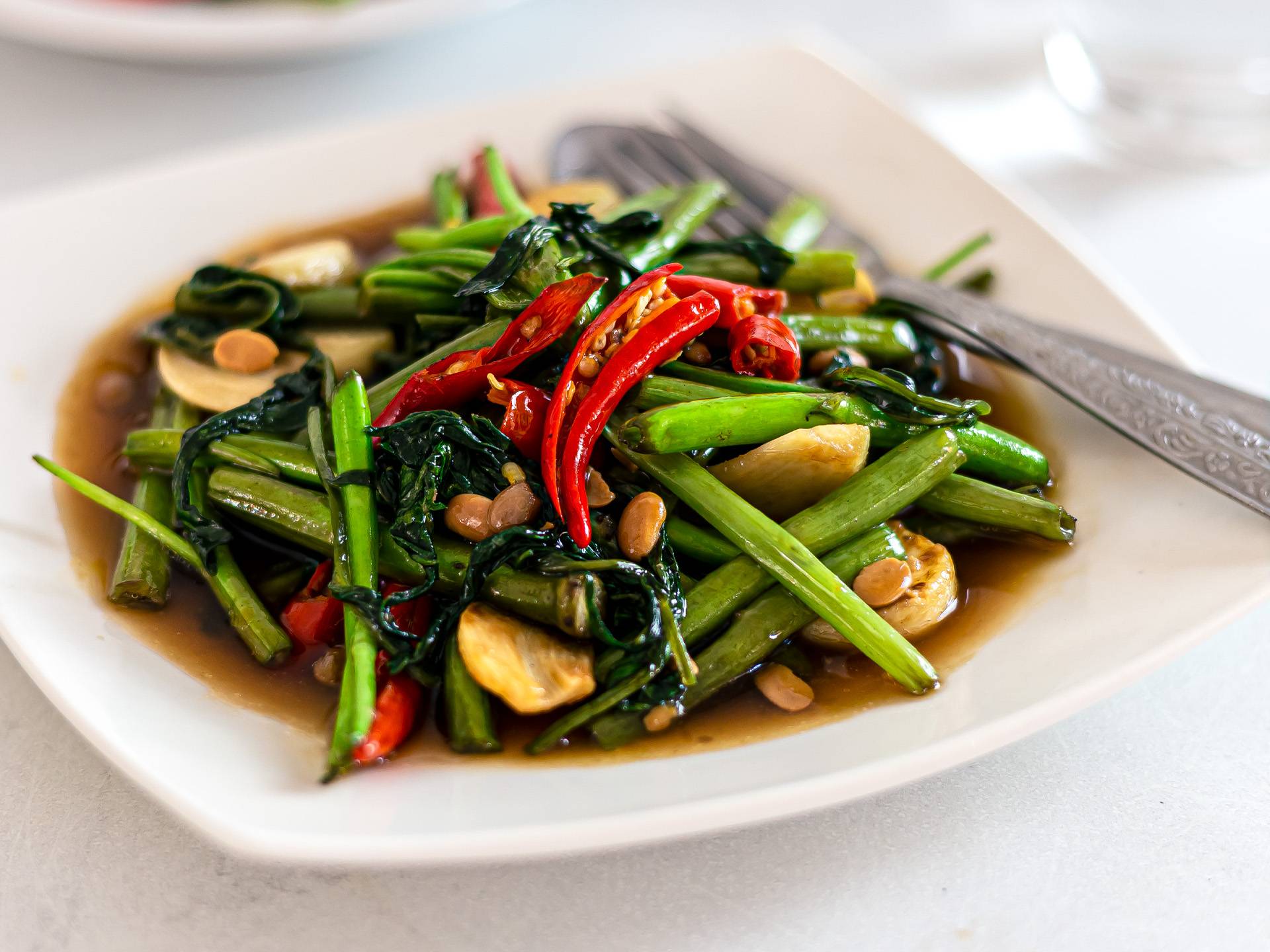During our year-long stay in Thailand, we fell in love with a delicious stir-fried vegetable dish made from pak boong, also known as morning glory or water spinach. It’s one of the easiest and quickest Thai dishes you can make, yet it’s packed with flavor. Let us show you how!
Morning Glory is a tropical vegetable with long, delicate, hollow stems and thin, oblong leaves. It is very common in Southeast Asia where it is well known kangaroo.
In Thailand it is called Morning Glory pak boong or phak exercise (ผักบุ้ง), and Thais really love a good pile of these stir-fried vegetables with their lunch or dinner, as a side dish or just because.
Fried morning glory, called pad pak boong fai daeng (ผัดผักบุ้งไฟแดง) is one of the most popular Thai foods. Almost any restaurant in Thailand would serve you this, and it’s such a must-try for first-time visitors.
Fried morning glory tastes salty, sweet and spicy – the three main flavors of Thai cuisine. We really like the contrast between the soft leaves and the crunchy stems!
Close pad pack goodsimply stir-fry chopped morning glory with garlic and fresh red chillies in a very hot wok and season with a mixture of fermented soybean sauce, oyster sauce and fish sauce.
What’s the secret to a perfect fried Thai-style morning glory?
Season the sauce to taste and cook the morning glory until the leaves are just wilted and the stalks are still crispy and light green. We will tell you all about it in the following recipe steps.
To learn more about morning glory, the ingredients, and the tools you’ll need to make this recipe, see the FAQ section below. There we also suggest some alternatives if you can’t find local Thai ingredients.
frequently asked Questions
What is the name of the Thai food Morning Glory?
Called pak boong or phak exercise (ผักบุ้ง) In Thai, morning glory is a leafy green vegetable with long, hollow stems and thin leaves that is popular in Thai stir-fries.
Morning Glory is a semi-aquatic, tropical plant grown as a vegetable in Southeast Asia for its delicious shoots. It looks a bit like a cross between spinach and chard.
It has different names depending on the region, but is widely known as kangaroo or kungkung.
Other names for it include river spinach, swamp cabbage, water convolvulus, or water morning glory.
Is Thai morning glory like spinach?
Morning glory is a leafy green vegetable also known as “water spinach” because it resembles spinach and grows near waterways.
But compared to spinach, morning glory has crunchier shoots that are hollow inside and look like long straws. In addition, the leaves of morning glory are thinner and more elongated than those of spinach.
Where can I find Morning Glory?
Since morning glory is a tropical plant grown primarily in Southeast Asia, it is somewhat difficult to source in the West.
Still, you should be able to find it in your local Asian grocery stores.
can’t you find it Do not get discouraged! Try asking the seller as you may have missed their weekly delivery and they may be able to order the morning glory for you.
Alternatively, you can look for an online Asian ingredients vendor that can sell morning glory.
What is a good alternative to Morning Glory?
If you can’t find Thai Pak Boong, you can opt for other green leafy and stem vegetables.
Here are some great Morning Glory alternatives that you can try:
What ingredients do I need for Thai fried morning glory?
The 7 main ingredients of the fried morning glory are:
-
Morning Glory – green vegetable with long, hollow stems and thick leaves, usually sold in bundles (about 300g/10.5oz each) at Asian food markets;
-
Garlic – lots of fresh cloves of garlic are an essential ingredient in this Thai dish, but you can use fewer if you prefer;
-
Chilies – fresh red chilies are a must. Thai bird’s eye chillies or any other spicy chilies you like would be ideal;
-
Fish sauce – a thin and hearty sauce that you can substitute with soy sauce for a vegan alternative;
-
Oyster Sauce – a thick, dark, and glossy sauce for added color and flavor; Skip this to make vegan morning glory.
-
Fermented soybean paste — also known as yellow bean sauce — is a salty, light brown sauce with soybean chunks inside. It’s a mixture of fermented soybeans, soy sauce and sugar. If you can’t find it, you can substitute Japanese miso paste by following our directions in the recipe below;
-
Sugar – just a teaspoon or two for a sweet finish. You can substitute it with a sugar-free sweetener like erythritol for a healthier dish.
You’ll also need a large wok or skillet to sauté the morning glory, as well as a mortar and pestle if you want to pound the chilies and garlic like in the classic recipe – but that’s optional.

